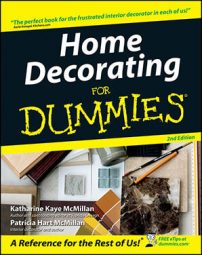Curtains and draperies work hard at blocking light, sound, and temperature. In addition to these functions, they’re also extraordinarily decorative, adding enormous personality to a room through color, pattern, and texture.
When choosing a patterned fabric for a curtain, especially an unlined curtain, scrunch the fabric in your hand. Doing so allows you to see how the pattern will look when gathered or pleated as it hangs at your window and how it will look with light streaming behind it. Don’t wait until the fabric has been made into curtains and hung in your room to be surprised!
Traditionally, windows were treated to three types of curtains:
A sash curtain (usually sheer, to filter light and provide some privacy)
A draw curtain (to block out light)
An overdrapery (which was purely decorative and stationary or unfunctional).
Today, draperies usually open and close (or draw) and are called draperies (a noun) never drapes (a verb).
In very formal rooms (with sufficiently high ceilings), all the layerings of window treatments were topped with a cornice or valance (to hide the hardware). This Traditional (expensive) multilayered treatment carries on today in period or very formal or dressy rooms.
Curtains and drapes are readily available as ready-mades in stock or standard lengths to conform to typical window sizes and ceiling heights. Finding ready-mades (generally less expensive than custom curtains) that work in your decorating project is possible. Perhaps they need only customizing with trim that’s available from a drapery or fabric shop. Or, you can embellish them with appliques and ribbons with which you can embellish plain panels.
Custom curtains allow you to choose the exact fabric needed for your interior design. Check out curtain design books, which can help you in deciding how simple or how lavish to make your curtains. Before you begin your curtain search, know that curtain designs often are a matter of selecting a heading (pleats and other decorative devices for gathering fabric into the desired fullness when hung at the window). You can choose from many different headings, but these are the more familiar:
Brisby pleats: What curtain makers call the technique of pinching pleats at the top, where rings are attached.
French pleats: Narrow folds neatly stacked and attached together (usually in groups of three pulled together) allowing for sewing rings on top or attaching pins for a traverse rod behind.
Pencil pleats: Narrow columns of folds that are continuous across the top of the drapery panel. These pleats must be tied or held back because they don’t fold, stack, and stay in place.
Smocked heading: A smocking tape (a band of fabric with rows of cords that can be pulled, gathering material as the cords are pulled) creates a dressmaker’s touch.
Curtains and draw draperies are often topped off by a separate item that essentially hides hardware, but may serve additional decorative purposes:
Cornice: A cornice is an upholstered wood shape (usually architectural, but it may be entirely fanciful in design).
Lambrequin: Think of a cornice that extends to the floor, creating a shadow box effect and adding a sense of architecture to both Traditional and Contemporary interiors. Use lambrequins over bare windows, blinds, or full curtains.
Pelmet: A pelmet is an architecturally or artfully shaped fabric stiffened with buckram (a stiffly starched fabric that tailors and dressmakers use).
Valance: A valance is a soft, shortened version of a bedhanging or curtain that may be more elaborately pleated, shirred, gathered, and trimmed than the curtain over which it hangs. A valance may match your curtains in the same fabric, or you can coordinate it with your curtains with pattern, color, and/or texture. You can also line your valance with a contrasting fabric for some added oomph.

